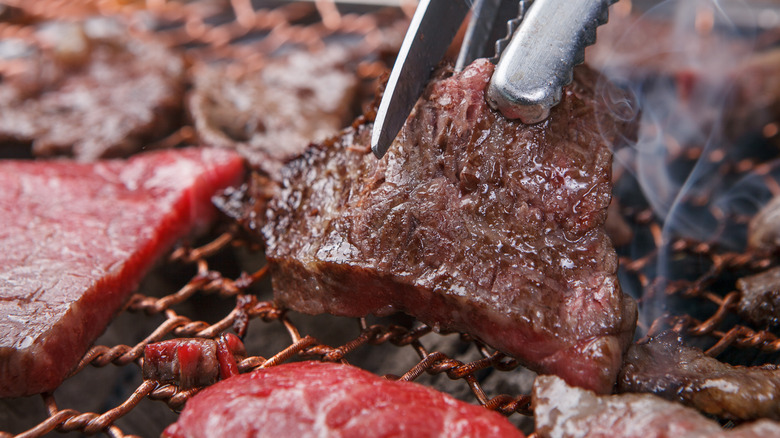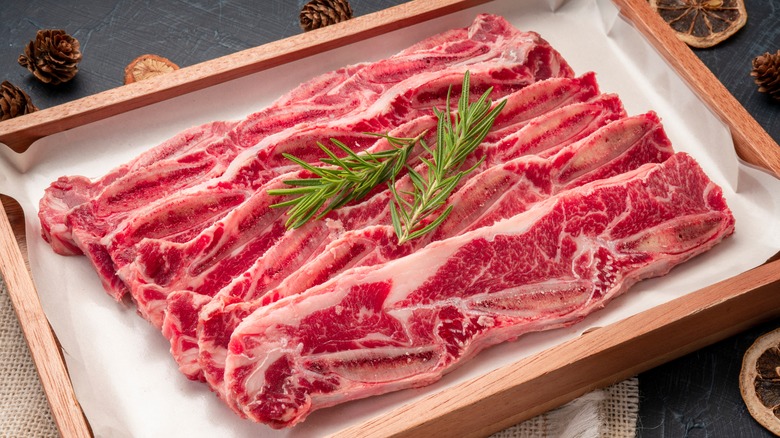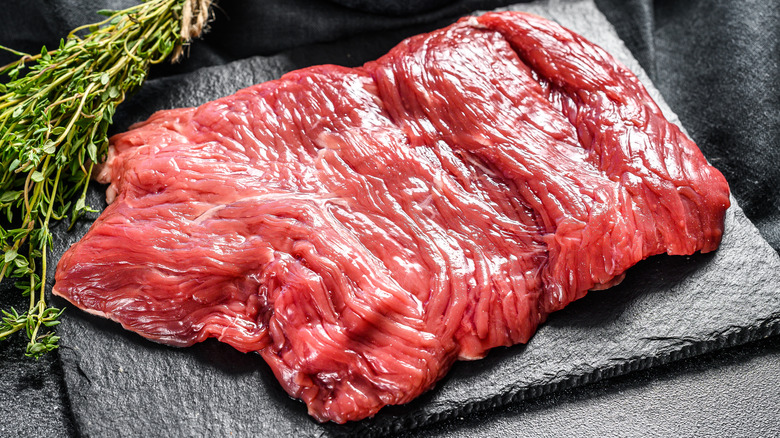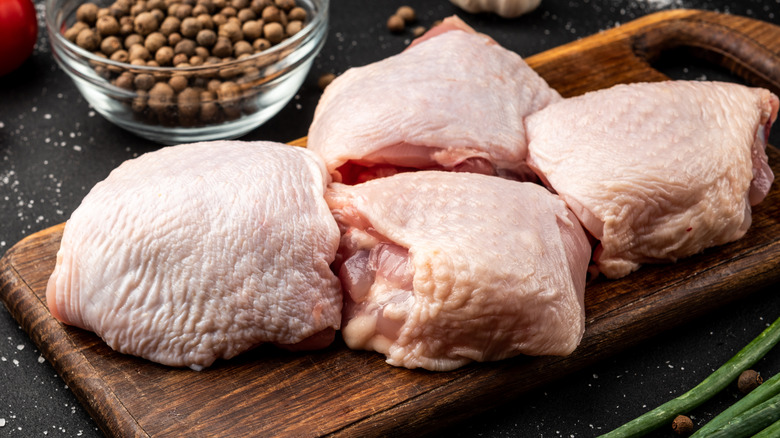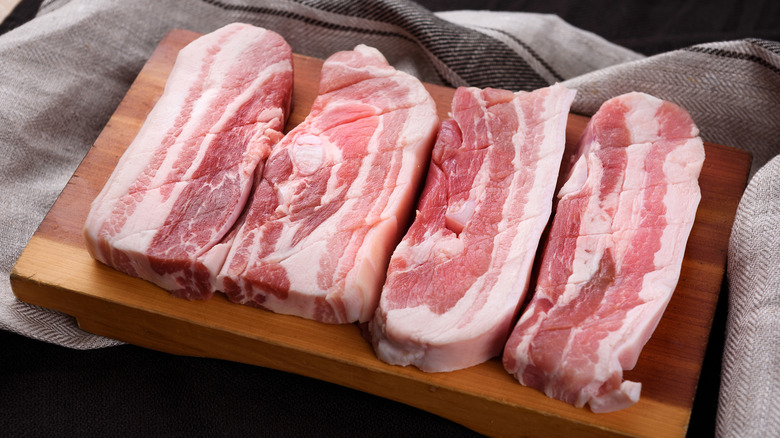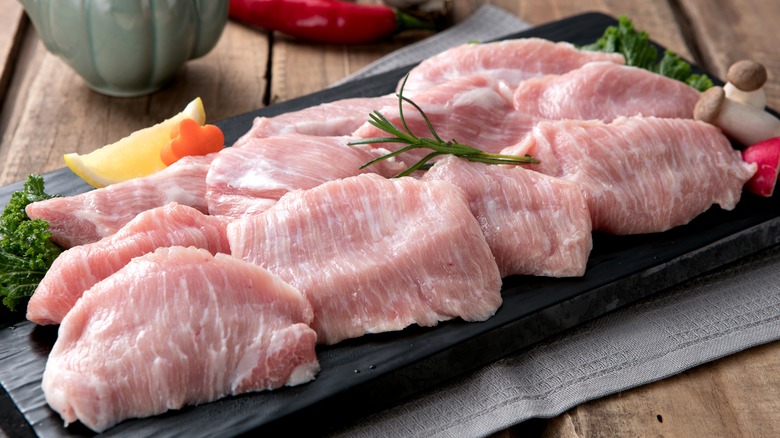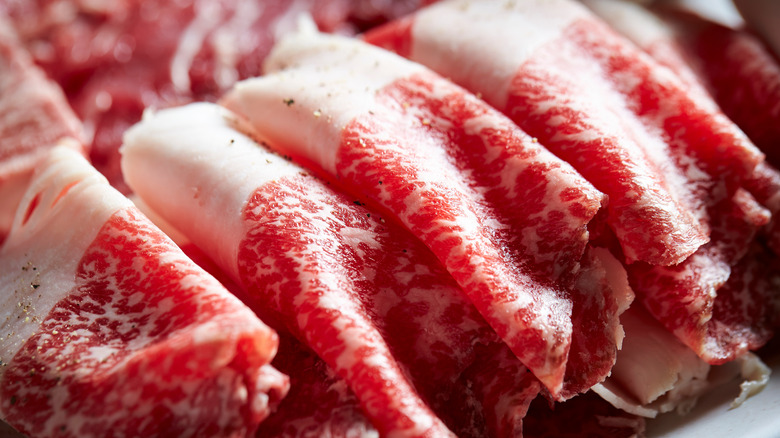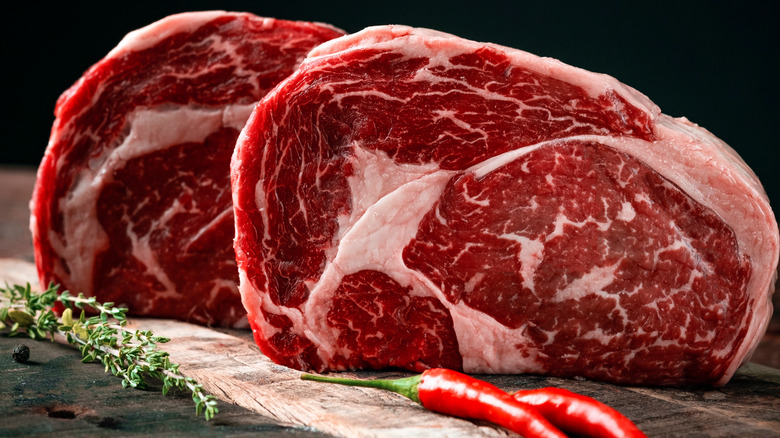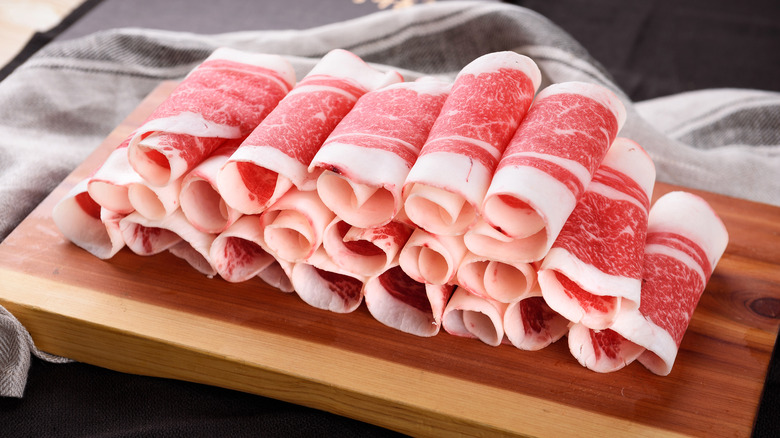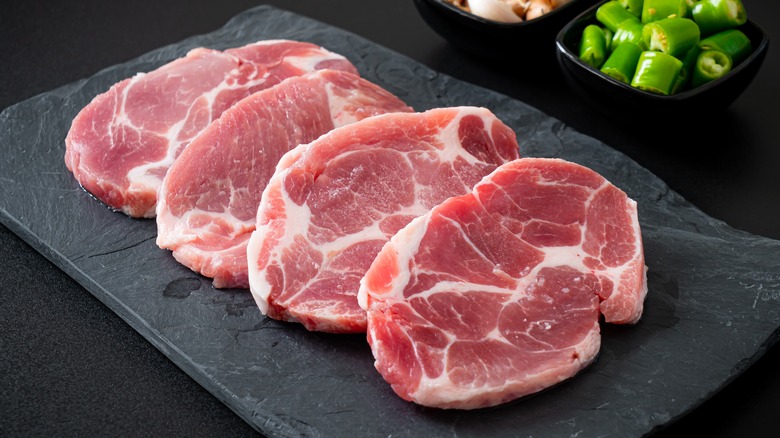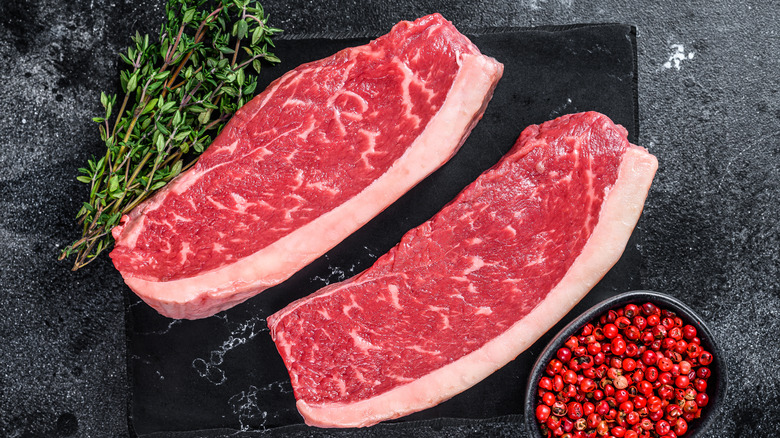10 Best Cuts Of Meat For Korean BBQ
Eating out at a Korean BBQ establishment should feel like an entire, effortless experience — one that delights the senses and begins the very second that unmistakable, savory scent of sizzling meat draws you to and through the door. Then there's the decor, the pleasantness and promptness of the staff, the perfectly prepared plates of banchan, and a few boozy drinks to match. All of this and more combine to create a memory that will make your mouth water for months, years, or an entire lifetime to come. And at the center of that Korean BBQ experience is, of course, the meat.
Deciding which meats to dish out at Korean BBQ can be challenging, especially if you're unfamiliar with cooking prime cuts of meat over open flames. That's why we spoke with Samuel Kim, an indisputable industry expert and the head chef of one of the absolute best Korean BBQ restaurants in the U.S., Baekjeong, to help explain all the best cuts of meats to grill over high heat.
Baekjeong, which translates in English to mean "butcher," is an authentic Korean BBQ restaurant known for its focus on finding quality, flavorful meat. So, what does Baekjeong's top chef have to say about choosing the best meat cuts for Korean BBQ? Let's find out!
1. Short rib (Kalbi 소갈비)
If one cut of meat represents the reliability of a Korean BBQ establishment, it is, without a doubt, the short rib. This particular cut has it all, with flavorsome bones, plentiful fat, and enough meat to make a difference. And, according to Chef Kim, the short rib is "the cut that Korean people judge a BBQ restaurant on ... because it lends very well to BBQ with the high heat, and people love the intramuscular marbling as well." Chef Kim also notes that it is important to know to source from either the 6th, 7th, or 8th rib of the cow, as he does when stocking from his own butchers, to get a greater return on short rib quality.
The benefits of cooking with short ribs, also called flanken-style ribs, can be primarily attributed to the cut's excellent fat-to-meat ratio, the flavor of the meat itself, and the unique balance of bone, fat, and meat that foodies far and wide will agree is downright fabulous. Plus, when a thin-cut short rib is introduced to a high-heat surface, such as a Korean BBQ grill, the fatty marbling will serve to protect the meat from becoming dry. With the lack of leanness in short ribs, the fat will melt into the meat as exterior browns and crisps, becoming a clear winner when it comes to crave-worthy cuts of meat for Korean BBQ.
2. Outside skirt steak (Ahnchangsal 안창살)
Everyone who enjoys a good steak probably knows a little bit about skirt steak. But what they may not know is that there are two types of skirt steak — the inside skirt steak and the outside skirt steak. And almost all of the negative skirt steak impressions come from having eaten a tough, overcooked piece of inside skirt. But those who have had the opportunity to taste the tender texture of a well-prepared outside skirt steak know better than to dismiss this cut of cattle, especially when it comes to Korean BBQ.
"Outside skirt steak is my favorite," said Chef Kim. "It is among the least ordered and most underappreciated ... but most people don't understand that the outside skirt is such a tender and flavorful piece of meat."
True to Chef Kim's description, the outside skirt is exactly what you want from your Korean BBQ beef experience, even though you may not know to order it off the bat. But if prepared correctly, this piece of meat has all the tenderness of a filet mignon, all the flavor of a New York strip, and all the satisfying feelings of fattiness as a ribeye. In other words, there's a reason the head chef of Baekjeong favors this cut.
3. Chicken thigh (Dalg Heobeogji 닭 허벅지)
Grilled chicken is something that just about everyone who enjoys meat would like to sink their teeth into, and a chicken thigh has all the fat, flavor, and crispy skin potential you could possibly want in your Korean BBQ. But be warned, not all restaurants are created equal, and an insider tip tells the truth about restaurants that serve too many selections on their menus:
"In Korea, the restaurants specialize," explained Chef Kim. "So, if you want chicken, you go to a restaurant that specializes in chicken." In other words, beware the restaurant that offers a little bit of everything including (but not limited to) seafood, steak, chicken, vegan, bacon and related pork products, Wagyu, Kobe, stew, and anything a la flambé. The larger the menu, the more room there is to make simple but unsavory mistakes that can take a meal from delicious to downright disappointing. Korean BBQ chicken thighs are a top-notch cut in terms of culinary potential, just be sure to source them from the correct restaurant before committing to the whole culinary experience.
4. Pork belly (Samgyupsal-gui 삼겹살 구이)
Pork belly is such an indulgent part of the pig, all tender meat interlaced with an incredible amount of fat just waiting to be kissed by the flame and turned into the most succulent, savory, and superbly juicy bite you've ever had the pleasure of putting in your mouth.
"Pork belly is a huge one," said Chef Kim. "It's just delicious and goes very well in Korean BBQ." This inherently impressive cut of pork is an ideal piece of meat to eat, especially when paired with the immediacy of Korean BBQ's grill-to-table transition. There's no waiting for your waiter to walk to your table with the Korean BBQ pork belly experience, and that flame-to-plate dynamic helps the pork belly's best qualities to shine. Chef Kim attests that pork belly contains more fat than other cuts of pork, such as the jowl, which makes it an ideal cut for the fat lovers out there who want a whole lot of sizzle for their Korean BBQ pork plates.
5. Pork jowl (Hangjeongsal 항정살)
"Really, pork jowl is what it's all about," said Chef Kim. And he is entirely right — this cut of pork is sourced from a pig's cheek and is where Korean BBQ customers can find some of the most uniquely unctuous and overall tasty bites one could possibly hope for. That is, if the pork in question is of a high enough quality to begin with and the person on the other end of those grilling thongs knows which end of the flame in front of them is up and which is down.
"Pork jowl is not something that as many Korean BBQ places carry," explained Chef Kim. "I was a fan of Baekjeong, before I worked here, back when I saw there was pork jowl on the menu. It was the first time I'd seen it, but now it's become a little bit more popular. It's got a little bit of a chew to it, an interesting texture, and a good amount of fat, but not as much as the belly." So, don't skip out on cheek cuts if you want to try some lesser-known but no less tasty meat to treat yourself to for Korean BBQ!
6. Beef brisket (Chadolbaegi 차돌박이)
There's a lot more to brisket than meets the eye, especially when it comes to cooking it hot and fast as you do in Korean BBQ. Though many American foodies may associate beef brisket more with low and slow barbeque than as something you slice thin and sear on high, there's a singular culinary charm to letting a charred cut of brisket melt across your mouth. This experience can only be achieved through incredibly high temperatures and impeccably good brisket.
"The brisket, you want to see on a menu," said Chef Kim."With [brisket], you want to make sure you're not just getting a brisket cut that's all red; you want to see some fat too because if you high grill such a lean cut, you'll have no choice but to cook it to well done. If there's no fat, then it'll be dry."
So, if you're ordering brisket at a Korean BBQ establishment, check to see if the fat's marbling is visible and plentiful in all of the slices. If it is, then you'll understand as soon as the meal is done why beef brisket easily makes the list of best cuts of meat for Korean BBQ.
7. Ribeye (Deungshim 등심)
According to a fair few culinary professionals, Chef Kim included, "fat is flavor." There are few cuts of any cow that can compare with the ribeye in terms of quality fat content combined with a reliably flavorful meat-to-fat ratio that many Korean BBQ customers enjoy.
"For such a long time in the U.S., fat had such a bad perception of being unhealthy," explained Chef Kim. "But we're realizing natural fats are much better than these processed fats and people are even getting into beef tallow. So, don't shy away from fat — it's really good and what you need [for cooking] at high, hot temperatures."
The best cuts for classic Korean BBQ can vary not only by region but by personal preference as well. With that in mind, it's good to remember that ordering out at Korean BBQ doesn't have to be an intimidating experience. So, if you see ribeye on the menu at a Korean BBQ and you're a fan of its fatty familiarity, don't feel as though you have to avoid it for authenticity's sake. After all, Chef Kim agrees that "Korean BBQ is all about choosing your own adventure and putting together whatever combination you like — there's no wrong way to do it."
8. Beef belly (Woo Samgyup 우삼겹)
Though beef belly may not be as abundantly extolled as its popular counterpart, pork belly, that doesn't mean this cut of cattle is any less exemplary when cooked hot and fast over an open flame. With an impeccably fatty frame surrounding well-marbled bits of meat, beef belly has everything Korean BBQ customers could possibly ask for in terms of texture and flavor.
"Beef belly is a very underrated cut; very much like pork belly, but beef," said Chef Kim. "It's a very similar cut to beef brisket as well and has a great mixture of meat to fat. So, if you like pork belly or beef brisket, you'll like beef belly."
And, as a less-frequently ordered cut on some Korean BBQ menus, beef belly could be used to gauge the overall process used to prepare the meat before you eat. While some locations may pre-slice the meat and freeze it for service, the best experience is had with meats that have been sliced to order, thus preserving the freshness, texture, and flavor. "You can tell when thin cuts like beef belly have been pre-sliced by the coloration, whether it was prepared well in advance or sliced to order," said Chef Kim.
9. Pork neck (Moksal 목살)
In the same way that a properly grilled yellowfin tuna collar is an incredibly underappreciated addition to any menu, so too are most cuts that come from the neck of any animal. Chief among these critically underrated neck cuts is king in Korean BBQ: pork neck. Though your instincts may be calling out for you to avoid this perhaps unfamiliar piece of meat, that would be a terrible mistake.
"We don't call the cut pork neck on our menu, just because some people can get turned off by that wording," said Chef Kim. "But the meat itself has a lot of connective tissue and lots of marbling, and that makes it popular among KBBQ customers. It's a little meatier than the jowl and with its own unique texture. I think it's very good." Rather than passing up one of the best cuts of meat for Korean BBQ, consider giving pork neck a chance to prove its place among the best barbeque cuts.
10. Sirloin (Deungsim 등심)
If you've ever wondered what cut goes into everyone's favorite Korean BBQ beef dish of bulgogi, look no further than the sirloin steak. This often overlooked piece of beef is known more for its flavor than its texture, which makes it an excellent recipient for recipes that involve a little bit of marinade. By marinating a less fatty piece of beef, you can incorporate ingredients that serve to break down the structure of the steak enough to render it ... well, tasting beautifully rendered.
The only pitfall of this more sirloin-specific quality is in those who would seek to utilize marinade to mask imperfections rather than to enhance the existing elements of the cut in question. "You get what you pay for, so the better quality of meat you pay for, the better the quality of that meat will be," explained Chef Kim. "You'll find that many meats that have been marinated at KBBQ places don't have a lot of flavor in the meat itself, and it was masked with marinade to cover the lack of quality." In short, don't skip the sirloin so long as you're sure the place providing it cares as much as you do about the quality of meat that you eat.
